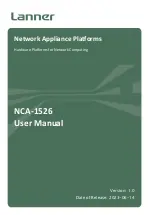
AT-8100 Series Version 2.2.5.0 Web Interface User’s Guide
189
The following steps illustrate the authentication process that occurs
between the switch and an authentication server when a manager logs on:
1. The switch uses its RADIUS or client to transmit the
username and password to an authentication server on the network.
2. The server checks to see if the username and password are valid.
3. If the combination is valid, the authentication server notifies the switch,
which completes the login process, allowing the manager access to its
management software.
4. If the username and password are invalid, the authentication protocol
server notifies the switch, which cancels the login.
Accounting
Information
RADIUS and also provides a way to monitor usage by login
users. You can configure the switch to send a start accounting message at
the beginning of a session and a stop accounting message at the end of
the session to an authentication sever.
Configuring
RADIUS and
To authenticate using a RADIUS or server, you must configure
remote manager authentication and add authentication servers that the
switch can access.
You can configure up to three servers each for the RADIUS and
features. However, only one authentication method can be
used at a time, either RADIUS or .
To configure remote manager authentication and add authentication
servers, choose from the following procedures:
“Configuring RADIUS for Remote Manager Authentication” on
page 191
“Configuring for Remote Manager Authentication” on
page 195
Placing RADIUS
and
Servers in the
Client’s List
When a user logs on to the switch, the authentication client polls the
servers for authentication information in the order in which they are listed
in the client. The order that you add a server determines its order on the
client. For instance, the first server that you add becomes Server 1, the
second server that you add becomes Server 2, and the third server that
you add becomes Server 3.
When you remove a server from the switch, the place holder is retained.
For example, you make the following assignments:
Server 1 has an IP address of 192.168.10.11
Server 2 has an IP address of 192.168.10.12
Server 3 has an IP address of 192.168.10.13
Содержание AT-8100L/8POE
Страница 4: ......
Страница 10: ...Contents 10...
Страница 14: ...Figures 14...
Страница 22: ...Chapter 1 AT 8100 Series Version 2 2 5 0 Web Browser Interface 22...
Страница 84: ...Chapter 5 Setting Port Statistics 84...
Страница 90: ...Chapter 6 Port Mirroring 90 6 Click Apply 7 Click SAVE to save your changes to the startup configuration file...
Страница 92: ...Chapter 6 Port Mirroring 92...
Страница 100: ...Chapter 7 Spanning Tree Protocol on a Port 100...
Страница 120: ...Chapter 9 Link Aggregation Control Protocol LACP 120...
Страница 130: ...Chapter 10 Setting Static Port Trunks 130...
Страница 148: ...Chapter 12 Spanning Tree Protocols on the Switch 148...
Страница 158: ...Chapter 13 Internet Group Management Protocol IGMP Snooping 158...
Страница 168: ...Chapter 14 IGMP Snooping Querier 168...
Страница 178: ...Chapter 15 Power Over Ethernet PoE 178...
Страница 230: ...Chapter 19 Setting IPv4 and IPv6 Addresses 230...
Страница 242: ...Chapter 20 Access Control Lists ACL 242...
Страница 246: ...Chapter 21 Setting Static Routes 246 8 Click Apply 9 Click SAVE...
Страница 250: ...Chapter 21 Setting Static Routes 250...
Страница 319: ...AT 8100 Series Version 2 2 5 0 Web Interface User s Guide 319 Model Name Asset ID...
Страница 320: ...Chapter 25 LLDP and LLDP MED 320...
















































